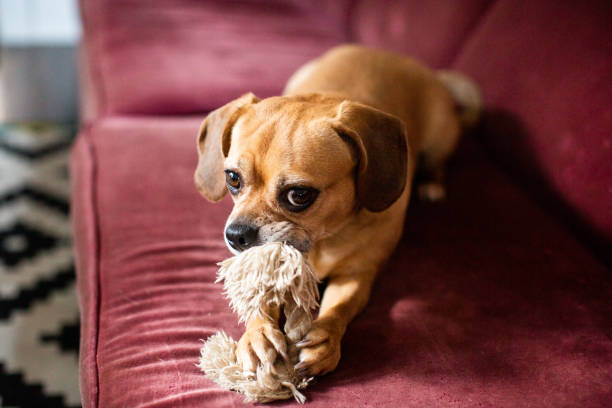Puggle

Breed History:
The Puggle is a popular hybrid dog breed created by crossing a Pug and a Beagle. This designer breed emerged in the late 20th century, primarily in the United States, as breeders sought to combine the affectionate, charming nature of the Pug with the energetic, playful qualities of the Beagle. The goal was to create a friendly, sociable, and adaptable companion dog with a balanced temperament.
Though not a purebred, the Puggle quickly gained popularity as a family pet due to its lovable personality, moderate size, and relatively low-maintenance coat. They are often appreciated for their playful spirit and sociability.
|
Gender |
Height |
Weight |
|
Male |
30–38 cm |
9–14 kg |
|
Female |
28–35 cm |
7–13 kg |
Size – Small to Medium
Life Expectancy: 10–15 years

Breed Appearance:
The Puggle typically has a compact, muscular body with a short coat that can vary in color, often showing fawn, tan, black, or combinations. They have a somewhat wrinkled face reminiscent of the Pug, but usually with a longer snout inherited from the Beagle.
Their ears are floppy, and their eyes are large and expressive, conveying a friendly, inquisitive nature. The tail is often curled like a Pug’s but can be straighter depending on genetics. Overall, Puggles have an adorable “mixed” look blending the best of both parent breeds.
Breed Type – Family/Companion:
Puggles are affectionate, social, and great with families and children. They tend to get along well with other pets and thrive on human interaction. Their friendly and playful temperament makes them excellent companion dogs for active families or individuals.
However, they inherit a strong prey drive and curiosity from the Beagle side, so early socialisation and training are important to manage their behaviour and reduce tendencies to chase small animals or wander.

Training:
Puggles are intelligent but can sometimes be stubborn, combining the independent streak of the Beagle with the charm of the Pug. Positive reinforcement, consistency, and patience are key in training.
They respond well to treats, praise, and interactive games, but early obedience training and socialisation are necessary to prevent unwanted behaviours like excessive barking, digging, or pulling on the leash.
Health & Care:
Puggles generally have good health and a lifespan of 10 to 15 years, though as hybrids, they may inherit health issues from either parent breed. Common concerns include hip dysplasia, patellar luxation, respiratory issues related to the Pug’s brachycephalic face, and ear infections from floppy ears.
Routine veterinary care, a balanced diet, and regular exercise are essential for their well-being. Maintaining a healthy weight is particularly important due to their tendency to gain weight if overfed.

Living Conditions:
Puggles adapt well to a variety of living environments, including apartments and houses, as long as they receive sufficient exercise. They enjoy spending time indoors with their families and appreciate having a safe, secure yard to explore.
Because of their social nature, Puggles do not like to be left alone for long periods and can develop separation anxiety if neglected. They thrive best in homes where they get plenty of attention and companionship.
Exercise:
Moderate daily exercise is necessary to keep a Puggle happy and healthy. This can include walks, playtime, and mental stimulation through games and training.
Their Beagle heritage gives them an energetic streak, so they enjoy activities that engage their scenting ability and curiosity. Without enough exercise, they may become bored and develop destructive behaviours.
Grooming:
Puggles have short, smooth coats that are relatively low-maintenance. Weekly brushing helps remove loose hair and keeps the coat shiny.
Regular ear cleaning is important to prevent infections, especially due to their floppy ears. Nail trimming, dental care, and occasional baths will keep them healthy and comfortable.

Advantages:
-
Friendly, affectionate, and great with families and children
-
Moderate size suitable for apartments or houses
-
Low grooming needs and a relatively clean coat
-
Intelligent and trainable with proper consistency
-
Adaptable to various living conditions and social environments
Disadvantages:
-
Can inherit respiratory issues from the Pug, requiring care in hot or humid weather
-
Strong prey drive and curiosity may lead to chasing or wandering
-
Potential for stubbornness requiring patient, consistent training
-
May develop separation anxiety if left alone too long
-
Possible health issues inherited from either parent breed

